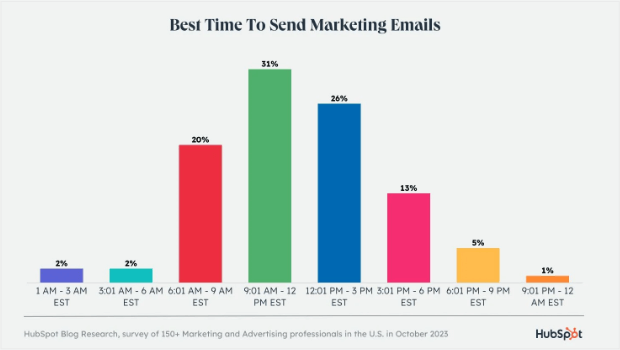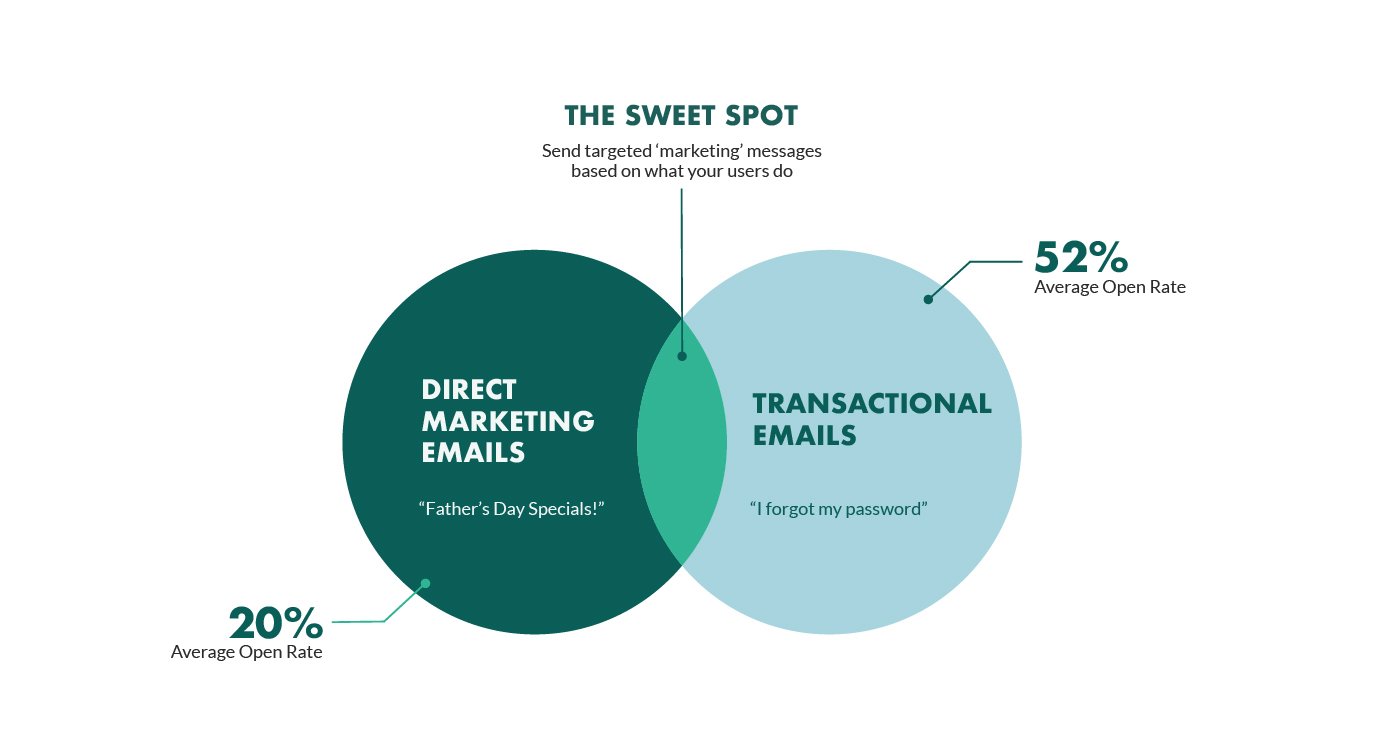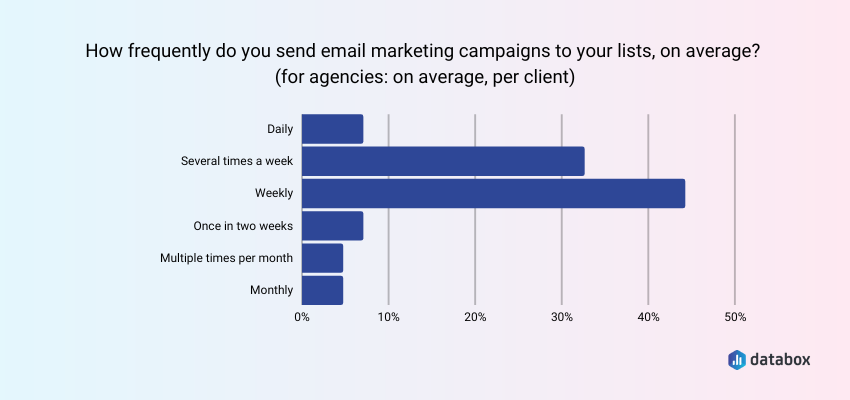Marketing emails are powerful tools. They can engage and convert customers.
But when is the best time to send them? Knowing when to send marketing emails can make a big difference. Timing affects whether your email gets opened or ignored. Send it at the wrong time, and your message might be lost.
But send it at the right time, and your chances of success increase. Understanding the optimal times for sending marketing emails can boost your engagement rates and improve your overall marketing strategy. This blog will explore the best times and days to send your marketing emails, helping you reach your audience effectively.

Credit: optinmonster.com
Best Days To Send Marketing Emails
Understanding the best days to send marketing emails can significantly impact your campaign’s success. Choosing the right days ensures higher open rates, better engagement, and improved conversions. Let’s dive into the optimal days to send your marketing emails.
Weekday Vs Weekend
Weekdays typically outperform weekends for email marketing. People are more likely to check their emails during workdays. The best days usually are Tuesday, Wednesday, and Thursday. Sending emails during these days often results in higher open and click-through rates.
Weekends may not be as effective. People tend to disconnect from work-related tasks. Emails sent on weekends often experience lower engagement. Yet, some businesses might find success depending on their target audience and industry.
Industry-specific Insights
Different industries might have unique trends for optimal email sending days. Here are some industry-specific insights:
| Industry | Best Days |
|---|---|
| Retail | Tuesday, Thursday |
| Finance | Monday, Wednesday |
| Healthcare | Wednesday, Friday |
| Technology | Tuesday, Thursday |
Analyzing your industry’s trends can provide a clearer picture of when to send your emails. It’s also essential to test different days to see what works best for your specific audience.
Optimal Times Of Day
Finding the optimal times of day to send marketing emails can significantly impact your open and click-through rates. The time at which recipients are most likely to engage with your content varies. Below, we explore the best times to send marketing emails.
Morning Vs Afternoon
Sending emails in the morning is often effective. People check their inboxes as part of their morning routine. Early morning emails (between 7 AM and 9 AM) tend to have higher open rates.
In the afternoon, engagement can vary. Many recipients may be busy with work tasks. However, sending emails between 1 PM and 3 PM can be effective. This is especially true if your audience takes lunch breaks or has a dip in productivity.
Key Takeaways:
- Morning: 7 AM to 9 AM
- Afternoon: 1 PM to 3 PM
Evening Engagement
Evening emails can also perform well. People often check their emails after work. Sending emails between 6 PM and 9 PM can capture this audience.
Late evening emails (after 9 PM) may not be as effective. Recipients might be less likely to engage with marketing content late at night.
Key Takeaways:
- Evening: 6 PM to 9 PM
- Late Evening: After 9 PM (less effective)
Understanding the optimal times of day to send marketing emails can enhance your email marketing strategy.
Considering Time Zones
Timing is crucial in email marketing. Sending emails at the wrong time can result in low open rates. This is especially true for businesses with a global audience. It’s important to consider the time zones of your recipients. This ensures your emails arrive at the right time. Below are strategies for managing time zones effectively.
Global Audience Strategies
When you have a global audience, you need to plan carefully. Here are some tips:
- Segment your email list: Group recipients by their time zones. This helps you send emails at the optimal time for each group.
- Use email scheduling tools: Many email marketing platforms offer scheduling features. These tools can send emails at the best times for different time zones.
- Test different times: Experiment with sending emails at various times. Analyze the data to find the best time for each region.
Below is an example of how you might segment your email list:
| Region | Time Zone | Optimal Send Time |
|---|---|---|
| North America | EST | 10 AM – 11 AM |
| Europe | CET | 9 AM – 10 AM |
| Asia | IST | 11 AM – 12 PM |
Local Market Focus
If your business focuses on a local market, timing is still key. Here’s how you can optimize email timing for local audiences:
- Analyze your local audience behavior: Use analytics to understand when your audience is most active. This helps you choose the best times to send emails.
- Consider local holidays and events: Avoid sending emails during major holidays or local events. People are less likely to check their inboxes during these times.
- Send during business hours: Emails sent during business hours are more likely to be opened. Aim for mid-morning or early afternoon for best results.
Understanding and considering time zones can greatly improve your email marketing success. Apply these strategies to ensure your emails reach recipients when they are most likely to engage.

Credit: www.superoffice.com
Seasonal Timing
Effective marketing emails require the right timing. Seasonal timing plays a crucial role in email marketing success. Planning emails around seasons can boost engagement and conversions. This approach helps marketers reach their audience at the perfect moment.
Holiday Campaigns
Holidays present golden opportunities for email marketing. Think Christmas, Thanksgiving, or Valentine’s Day. People expect deals and special offers during these times. Sending emails before and during holidays can capture buyers’ attention. Highlight your best products or services to stand out. Make sure your emails are festive and appealing.
Timing is key. Start your holiday campaign well in advance. Build anticipation with teaser emails. Follow up with reminders and last-minute deals. This strategy keeps your brand top of mind. Your audience will be more likely to engage and make a purchase.
Off-peak Opportunities
Not all marketing efforts should focus on peak seasons. Off-peak periods offer unique advantages too. These times often see less competition in inboxes. Your emails have a better chance of standing out. Use this opportunity to build relationships and nurture leads.
Think about summer months or back-to-school periods. These times can be quieter but still valuable. Offer exclusive deals or share helpful content. Position your brand as a reliable source all year round. This approach keeps your audience engaged even when it’s not the holiday season.
Frequency Of Emails
Finding the right balance for email frequency is key. Too many emails can overwhelm your audience. Too few, and they may forget about you. How often should you send marketing emails? Let’s explore some guidelines.
Avoiding Spam
Send emails too often, and your recipients may mark them as spam. This damages your sender reputation and decreases your open rates. Here’s how to avoid it:
- Stick to a regular schedule. Consistency is important.
- Monitor your unsubscribe rates. High rates indicate over-emailing.
- Use clear and engaging subject lines. Avoid all caps and excessive punctuation.
Maintaining Interest
Keep your audience engaged by not overloading them. Quality over quantity is key. How can you maintain interest?
- Send valuable content. Offer tips, advice, or exclusive deals.
- Personalize your emails. Use the recipient’s name and tailor the content.
- Test different frequencies. Find what works best for your audience.
Here is a table that summarizes the key points:
| Tip | Action |
|---|---|
| Avoid Spam | Stick to a schedule, monitor unsubscribe rates, use clear subject lines |
| Maintain Interest | Send valuable content, personalize emails, test frequencies |

Credit: databox.com
Audience Behavior Analysis
Understanding your audience is key to successful email marketing. Knowing when your audience is active ensures higher engagement. Audience behavior analysis helps pinpoint the best times to send marketing emails. This section explores critical factors like open rates and click-through rates.
Open Rates
Open rates indicate how many recipients open your emails. Timing impacts open rates significantly. Early morning emails often get higher open rates. Many people check their emails first thing in the morning. Late evening also sees a spike in open rates. People tend to check emails before bed.
Click-through Rates
Click-through rates show how many people click links in your emails. High click-through rates mean your content resonates with the audience. Mid-morning and early afternoon are prime times. People are more engaged during these hours. Testing different times can improve your click-through rates.
A/b Testing For Timing
A/B testing for timing can significantly improve your email marketing strategy. It involves sending emails at different times to find the optimal delivery window. This method allows you to understand when your audience is most likely to engage with your emails. By finding the best times, you can increase open rates and conversions.
Experimentation Techniques
Start by selecting two different times to send your emails. These times should be based on your audience’s behavior and habits. For example, you might choose 10 AM and 2 PM. Then, split your email list into two equal groups. Send one group the email at the first time and the other group at the second time.
Ensure your test runs for a few weeks to gather enough data. This helps in getting a more accurate picture of what works best. Keep your email content identical. Only the timing should differ. This ensures that any changes in engagement are due to timing, not content.
Analyzing Results
Once your test period is over, compare the results from both groups. Look at metrics like open rates, click-through rates, and conversions. These will show which time led to better engagement.
Use these insights to refine your email timing strategy. If 10 AM shows higher engagement, then consider sending future emails at that time. Continuously test and tweak your times. This keeps your strategy effective and up-to-date.
Tools For Scheduling Emails
Scheduling marketing emails can enhance your campaign’s effectiveness. Using the right tools ensures your emails are sent at the optimal time. This section explores essential tools for scheduling emails.
Automation Software
Automation software helps streamline your email marketing. It allows you to set up campaigns that run on their own.
Popular options include:
- Mailchimp – User-friendly and versatile.
- HubSpot – Great for inbound marketing.
- Sendinblue – Offers advanced automation features.
These tools allow you to schedule emails based on:
- Time zones
- User behavior
- Custom triggers
Automation tools save time and ensure consistency in your campaigns.
Analytics Tools
Analytics tools offer insights into your email campaigns. They help you understand what works and what doesn’t.
Some top analytics tools are:
- Google Analytics – Monitors traffic and engagement.
- Litmus – Tests email performance across devices.
- Campaign Monitor – Provides detailed reports.
With these tools, you can track:
- Open rates
- Click-through rates
- Conversion rates
Analytics tools help refine your email strategy. They provide data to optimize future campaigns.
Frequently Asked Questions
What Is The Best Time To Send Marketing Emails?
The best time to send marketing emails is usually during weekdays, especially Tuesdays and Thursdays. Early mornings or late afternoons tend to have higher open rates.
Can Marketing Emails Be Sent On Weekends?
Yes, marketing emails can be sent on weekends. However, open rates are typically lower compared to weekdays.
How Often Should Marketing Emails Be Sent?
Marketing emails should be sent regularly but not too frequently. Once a week or bi-weekly is usually effective.
What Are The Legal Requirements For Sending Marketing Emails?
Legal requirements include obtaining consent, providing an unsubscribe option, and including your business address. Compliance with laws like GDPR is essential.
Conclusion
Timing matters when sending marketing emails. The right moment boosts engagement. Early morning or mid-week are often best. Test different times for your audience. Analyze what works. Respect time zones and avoid weekends. Consistent timing builds trust. Use clear, compelling subject lines.
Craft valuable content. Stay relevant and concise. Always allow easy opt-outs. Happy customers lead to better results. Remember, timing is key.



Leave a Reply